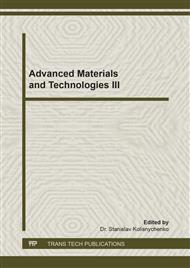[1]
Price L., Worrell E. and Phylipsen D. Energy use and carbon dioxide emissions in energy-intensive industries in key developing countries. Berkeley (CA): Ernest Orlando Lawrence Berkeley National Laboratory. 1999; [LBNL-45292].
DOI: 10.2172/783473
Google Scholar
[2]
Mehta, P. K. Global concrete industry sustainability. Concrete International. 2009; 31(2): 45–48.
Google Scholar
[3]
Reddy, B.D., Jyothy, S.A. and Ramana, I.V. Effect of rice husk on the properties of ordinary Portland cement with and without superplasticizers. Inter., J. of Civil and Structural Eng., Research and Development. 2013; ISSN: 2249-6866: 3(2): 1-8.
Google Scholar
[4]
International Agency for Research on Cancer (IARC). Monograph on the evaluation of carcinogenic risk to humans. World Health Organization. 1997; 68(1): 2-9.
Google Scholar
[5]
Nair, D., Fraaij, A., Klaassen, A., and Kentgens, A. A Structural investigation relating to the pozzolanic activity of rice hush ashes. Cement and Concrete Research (Elmsford). 2008; 38(6): 861 – 869.
DOI: 10.1016/j.cemconres.2007.10.004
Google Scholar
[6]
Naji, A.G., Suraya, A.R., Farah, A.A, and Mohamad, S.M. Constrruction of rice husk ash to the properties of mortar and concrete. Journal of American Science. 2010; 6(3).
Google Scholar
[7]
Tuleun, L.Z. and Jimoh, A.A. Laboratory evaluation of the performance of calcium carbide waste (hydrated lime) in concrete. Websjournal of Science and Engineering Application. 2018; WESEA ISSN, 1974-1400-X: 8(1): 494 – 502.
Google Scholar
[8]
Tanalapsakul, A. Document from thai industrial company limited. M. Thai Industrial Company Limited, Samutsakoon. (2008).
Google Scholar
[9]
Jaturapitakkul, C. and Roongreung, B. Cementing materials from calcium carbide resisdue rice husk. Journal of Materials in Civil Engineering. 2003; 15(5): 470-475.
DOI: 10.1061/(asce)0899-1561(2003)15:5(470)
Google Scholar
[10]
BS 197–1:2000. Cement composition, specification and conformity criteria for common cements. British Standards Institution, London, U.K.
Google Scholar
[11]
Jimoh, A.A., Ameen, O.M. and Atolagbe, J.A. Determination of optimum burning time and silica composition of rice (oryzasativa) husk ash and guinea-corn (sorghum bicolar) husk ash for pozzolana production. Journal of Chemical Sciences Nigeria. 2017; 42(10): 7-11.
Google Scholar
[12]
BS EN 196 – 3 (1994). Method for determination of setting time and soundness of cement. British Standard Institution, London, U.K.
Google Scholar
[13]
BS 1881–102:1983. Testing concrete – Method of determination of slump. British Standards Institute, London, U. K.
Google Scholar
[14]
BS EN 12390-3: 2002. Testing Hardened Concrete - Part 3: Compressive Strength of Test Specimens. British Standards Institute. London, U. K.
Google Scholar
[15]
ASTM C496-11 (2011).Splitting tensile strength of cylindrical concrete specimens. West Conshohocken: ASTM International.
Google Scholar
[16]
BS EN 12390-5: 2000. Testing Hardened Concrete - Part 3: Flexural Strength of Test Specimens. British Standards Institute. London, U. K.
Google Scholar
[17]
Dakroury, A.E. and Gasser, M.S. Rice husk ash (RHA) as cement admixture for immobilization of liquid radioactive at different temperature. Journal of Nuclear Material. 2008; 38(1): 271-277.
DOI: 10.1016/j.jnucmat.2008.08.026
Google Scholar
[18]
Zhang, M.H., Lastra, R. and Malhotra, V.M. Rice husk ash paste and concrete: Some aspects of hydration and the microstructure of the interfacial zone between the aggregate and paste. Cement and Concrete Research.1996; 26(6): 963-977.
DOI: 10.1016/0008-8846(96)00061-0
Google Scholar
[19]
Ganesan, K., Rajagopal, K. and Thangavel, K. Rice husk ash blended cement: assessment of optimal level of replacement for strength and permeability properties of concrete. Construction Building Material. 2008; 22(8): 675-683.
DOI: 10.1016/j.conbuildmat.2007.06.011
Google Scholar
[20]
Bhanumathidas, N. and Mehta, P.K. Concrete mixtures made with temary blended cement containing fly ash and rice husk ash. Proceedings of the Seventh Canmet International Conference. 2004; 379-91.
DOI: 10.14359/10505
Google Scholar
[21]
ASTM C-618.Standard specification for coal fly ash and raw or calcined natural pozzolan for use in concrete. Annual Book of ASTM Standard. 1999; 4(2).
DOI: 10.1520/c0618-12a
Google Scholar
[22]
Neville, A.M. Properties of concrete.3rd edition, Pitman publishing limited 39 Parker street, London WC2B 5PB. 2011; ISBN, 0-273-01641-5: 433-451.
Google Scholar
[23]
Gupta, B.I. and Gupta, A. Concrete technology. Standard Publishers Distributors, 1705-B, Nai Sarak,Post Office No.: 1066,Delhi-110006. 2004; ISBN: B1-8014-040-7.
Google Scholar
[24]
Krishna, K.N., Sandeep, S. and Mini, K.M. Study on concrete with partial replacement of cement with rice husk ash. IOP Conf Series: Materials and Science Engineering. 2016; 149.
DOI: 10.1088/1757-899x/149/1/012109
Google Scholar


